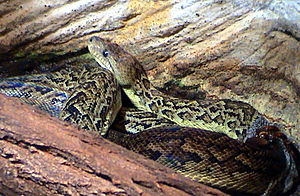Cuban boa
== Cuban Boa ==
The Cuban boa (Chilabothrus angulifer), also known as the Cuban tree boa, is a species of non-venomous boa endemic to the island of Cuba. It is a member of the Boidae family and is known for its distinctive coloration and behavior.
Description[edit | edit source]
The Cuban boa is a medium to large-sized snake, with adults typically reaching lengths of 4 to 6 feet. It has a slender body and a distinctive pattern of dark brown or black markings on a lighter background. The Cuban boa is arboreal, meaning it spends much of its time in trees, where it hunts for small mammals and birds.
Distribution and Habitat[edit | edit source]
The Cuban boa is found throughout the island of Cuba, inhabiting a variety of habitats including forests, swamps, and agricultural areas. It is a nocturnal species, meaning it is most active at night when it hunts for prey.
Reproduction[edit | edit source]
Like other boas, the Cuban boa is ovoviviparous, meaning it gives birth to live young. Females typically give birth to a litter of 10 to 20 offspring, which are born fully developed and able to fend for themselves.
Conservation[edit | edit source]
The Cuban boa is listed as a species of least concern by the International Union for Conservation of Nature (IUCN). However, habitat loss and fragmentation pose a threat to its populations, particularly in areas where deforestation is occurring.
See Also[edit | edit source]
Search WikiMD
Ad.Tired of being Overweight? Try W8MD's physician weight loss program.
Semaglutide (Ozempic / Wegovy and Tirzepatide (Mounjaro / Zepbound) available.
Advertise on WikiMD
|
WikiMD's Wellness Encyclopedia |
| Let Food Be Thy Medicine Medicine Thy Food - Hippocrates |
Translate this page: - East Asian
中文,
日本,
한국어,
South Asian
हिन्दी,
தமிழ்,
తెలుగు,
Urdu,
ಕನ್ನಡ,
Southeast Asian
Indonesian,
Vietnamese,
Thai,
မြန်မာဘာသာ,
বাংলা
European
español,
Deutsch,
français,
Greek,
português do Brasil,
polski,
română,
русский,
Nederlands,
norsk,
svenska,
suomi,
Italian
Middle Eastern & African
عربى,
Turkish,
Persian,
Hebrew,
Afrikaans,
isiZulu,
Kiswahili,
Other
Bulgarian,
Hungarian,
Czech,
Swedish,
മലയാളം,
मराठी,
ਪੰਜਾਬੀ,
ગુજરાતી,
Portuguese,
Ukrainian
Medical Disclaimer: WikiMD is not a substitute for professional medical advice. The information on WikiMD is provided as an information resource only, may be incorrect, outdated or misleading, and is not to be used or relied on for any diagnostic or treatment purposes. Please consult your health care provider before making any healthcare decisions or for guidance about a specific medical condition. WikiMD expressly disclaims responsibility, and shall have no liability, for any damages, loss, injury, or liability whatsoever suffered as a result of your reliance on the information contained in this site. By visiting this site you agree to the foregoing terms and conditions, which may from time to time be changed or supplemented by WikiMD. If you do not agree to the foregoing terms and conditions, you should not enter or use this site. See full disclaimer.
Credits:Most images are courtesy of Wikimedia commons, and templates Wikipedia, licensed under CC BY SA or similar.
Contributors: Prab R. Tumpati, MD

